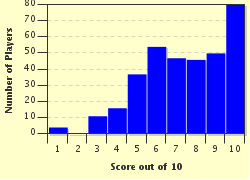Quiz Answer Key and Fun Facts
1. It is generally accepted that the first man to die for professing faith in Christ was Stephen, who was stoned by an angry mob for the crime of blasphemy. In which book of the New Testament is Stephen's trial and stoning described?
2. Most of Christ's disciples were martyred, but which one, according to Christian tradition, insisted on being crucified upside down because he did not feel that he was worthy to die in the same manner as Jesus?
3. With the establishment of the early church after the ascension of Christ, the new 'religion' experienced much opposition, both from the Judaic tradition from which Christianity sprang, and in large measure from the pantheistic Roman culture. The 2nd to 4th century period was known as the "Age of Martyrdom" for this reason. Which of the following martyrs met their death facing lions in the Colosseum?
4. This Roman soldier, part of the Guard of Diocletian, declared himself a Christian in the face of his emperor's decree that all Christian soldiers be arrested. He was subsequently tortured on the wheel of swords and then decapitated. Who was this martyr, whose exploits in life included a legend about slaying a dragon?
5. Thomas Becket, the Archbishop of Canterbury and Chancellor to the king, seemed to be in continual conflict with Henry II during his time in office. He fought for the rights and privileges of the Church to the point where he was found guilty of contempt of royal authority and malfeasance in the Chancellor's office. Further conflict over the coronation of Henry the Young King in 1170 led to a number of excommunications by Becket. Soon afterwards, supporters of the king assassinated Becket. Who was the Pope that canonized him as Saint Thomas a mere two years later?
6. Another well-known martyr from the Middle Ages was Joan of Arc, also known as the Maid of Orléans. Captured by the English during the Hundred Years' War, she was imprisoned, put on trial for heresy, and burned at the stake. In which city did this occur?
7. This man, famous for his Bible translation work, was arrested in 1535, imprisoned, choked, impaled, and then burned at the stake the following year. Who was he?
8. During the reign of Mary I in England, persecutions were carried out against Protestant reformers for heresy against the Catholic faith. At Oxford, three men were burned at the stake for heresy, becoming known as the 'Oxford Martyrs'. Which of these was not one of them?
9. Persecution for one's faith has continued into the modern era. In 1982, Pope John Paul II canonized Maximilian Maria Kolbe, a Conventual Franciscan friar, for giving his life for a stranger during the Second World War. He was declared a martyr of charity. At which German concentration camp did this occur?
10. During China's 'Cultural Revolution' (1966-76), many Christian leaders in Wang Zhiming's home of Wuding County were persecuted, including Zhiming and his family. After four years of imprisonment, on December 29th, 1973, he was executed. How?
Source: Author
reedy
This quiz was reviewed by FunTrivia editor
CellarDoor before going online.
Any errors found in FunTrivia content are routinely corrected through our feedback system.

